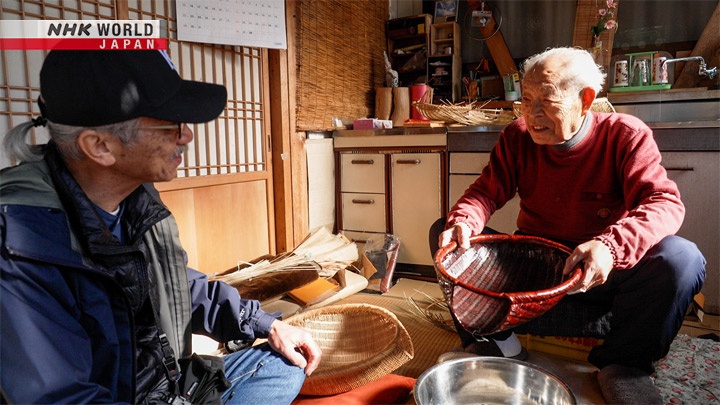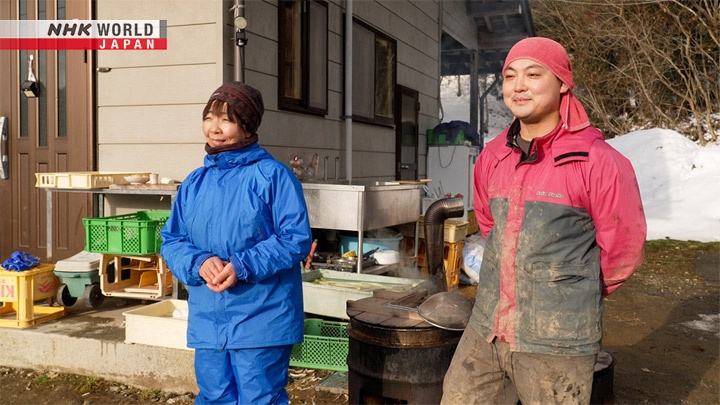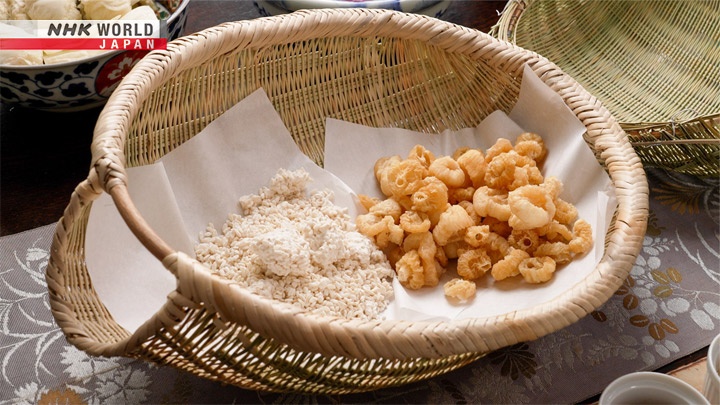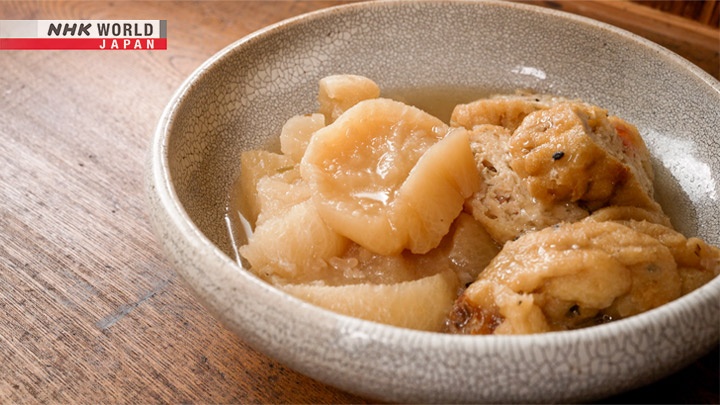Fermented Flavors and Friendships Make a Fine Feast
Winter in Hida, Gifu Prefecture, is cold and snowy indeed! Nobuko and her husband Makoto are preparing another fabulous feast to warm the hearts of their guests. They drop by their friend Hiroshi's shop for some malted rice, a traditional fermented essential, then visit their other pal Chieko for some homemade cold-dried daikon radish. Pairing the two ingredients with a myriad of others, Nobuko whips up a winter feast like none other. Discover the unique fermented flavors of mountainous Hida!






Transcript
Winter in mountainous Hida.
Cold air envelops the entire town.
In Japan, "satoyama" are small rural regions like this one where people live in harmony with nature.
Hello there! It's me, Tama!
Oh my! There's no fire in the fireplace!
Somebody, do something!
What took you so long?
Ah! That's much better!
Now that I'm all warm and toasty, I'm feeling a little peckish. Anything to eat?
Sure thing, Tama-san! Nobuko's already working on it.
In this guesthouse set up in a refurbished 100-year-old farmer's residence...
...the Kogawas enrich their leisurely life with home-cooked dishes from the culinary traditions of the Hida region.
This time, they prepare fermented dishes with malted rice as a key ingredient.
Born here, Chef Kogawa Nobuko is an enthusiast of the local cuisine.
Filming her is her husband Makoto, a seasoned cameraman.
And watching over the family is Tama-san.
So, ready your tastebuds for some fermented flavors prepared with malted rice and a dash of finely-aged friendship.
A brisk winter morning.
The Kogawa's friend, Kei, drops by.
I brought some.
He's here with some of his very first homegrown rice.
Plenty enough to make malted rice!
Yes, Nobuko is going to prepare malted rice: rice fermented with an ingredient called koji mold.
Malted rice, or rice malt, adds its uniquely rich aroma and deep flavor to any dish.
And it's indispensable to traditional winter recipes of the Hida region.
In order to turn Kei's rice into malted rice, they visit a shop in town that specializes in this versatile ingredient.
Thanks for having us.
What a lovely place!
Yanao Hiroshi used to be an architect.
But when he fell in love with the taste of rice malt, he renovated and converted an old house into a shop dedicated to it.
The Kogawas are welcomed by Taro the dog, and Mei, the goat.
Come in.
Amazing!
Like a different world.
I'll teach you how to make
malted rice at home.
Preparing malted rice is a lot of work, but if you get the hang of it, you could even make it at home.
First, lightly rinse the rice and let it soak in water for a day.
Then, let the water seep out over five hours.
After that, steam the rice for an hour, leaving it slightly firm.
Nice. It's like rice cake.
It's hard on the outside,
and soft on the inside.
The steamed rice is then spread on a table and let to cool down to about forty-five degrees Celsius.
Next, here comes the koji mold.
Koji mold breaks proteins down into amino-acids and starch into sugar,
drawing out the sweetness and umami, or savoriness, of any ingredient its added to.
The mold is sprinkled over the steamed rice.
Then we mix by hand.
This is to make sure the mold
gets on every grain.
Then, the rice is wrapped in an electric blanket for three days to let the koji mold do its work.
Like a baby bundled in its blanket, you gotta give it lots of tender loving care.
The ideal temperature for koji mold fermentation is between 35 and 40 degrees Celsius.
Leaving the rice to its own fate might cause it to get too hot.
It's best to allow it to breathe from time to time.
If it goes over 40℃, the koji mold
gets weak, and could even die out.
It needs a lot of care.
I can't wait to taste the results.
At night, Hiroshi checks the temperature.
So, is it ready now?
Let me have a taste!
Good morning!
It's ready!
It smells wonderful!
Fermented over three days, malted rice made from Kei's harvest.
The koji mold enveloped the rice, giving it a sweet aroma that's akin to chestnuts.
As for the taste...
It's a bit sweet...
Something wrong?
I don't have anything to compare it with.
Maybe it could be sweeter?
Hiroshi too looks concerned.
I give it 5...no 3 out of 10.
It's not sweet enough.
Rice can be quite resistant
to the koji mold.
The rice hasn't fermented as much as they'd expected.
But there's nothing to fear: all they need is to let it ferment some more and it'll become sweeter.
Looks like their malted rice needed a bit more time to mature.
But with a little more patience, they'll have an ingredient worthy of any feast.
I could go outside.
I'd better stay home.
Go outside? Nah, I'll stay home.
January 24th.
This one-day market is a yearly winter event in Hida.
The custom started when farmers of long ago would gather to sell items they handcrafted during the off seasons.
These are a traditional type of colander called "shoke".
They're multi-purpose strainers to remove water from produce or rice.
Wishing to offer a "shoke" to Nobuko, Makoto pays a master craftsman a visit.
The head of the "shoke" preservation association: Grandpa Mori.
Here's an example of his handiwork.
A "shoke" can be used to strain
water when rinsing rice.
When pounding rice cake,
you need this to strain water.
This opening lets you
pour out the rice...
after the water has strained.
Tap like this.
The rice won't stick.
In recent years, its simple yet beautiful hand-crafted look has made the "shoke" a popular ornamental piece.
It suits a Japanese decor.
But making a "shoke", which starts from the gathering of materials, is not simple at all.
Working the bamboo is difficult.
Weaving is hard,
but splitting it is harder.
Branches of a thin type of bamboo are split into eight thinner strips that will be woven to make the basket.
But it's easier said than done.
At each of his many attempts, Makoto always ends up breaking the bamboo.
Too thin.
But when Grandpa Mori does it...
I can only laugh.
It takes three years of practice...
to be able to split the bamboo
into nice and even thin strips.
It's time for some training under master Grandpa Mori.
Splitting the bamboo is too difficult, so Makoto focuses on learning the weaving.
He hopes to complete the "shoke" over the course of the long Hida winter.
Near the foot of the Hida mountains is an area that, until half a century ago, used to be closed off by snow during winter.
Yamanomura is a mountain village on a plateau at an altitude of a thousand meters.
It's nicknamed "the hamlet in the sky."
The area's winter climate, with temperatures as low as minus twenty degrees Celsius,
has given birth to a delicacy that's an essential part of Hida's wintertime feasts.
It's snowing sparsely.
Yamanomura must be covered.
Chieko will teach us how
to make cold-dried daikon radish.
It's gonna be cold.
Good morning!
Iwamoto Chieko prepares cold-dried daikon radish - the "winter delicacy" Nobuko is looking for.
Her friend Maehara-san will help with digging up the radishes.
We harvested them in the fall...
and buried them in bags.
It's hard work.
Daikon radishes harvested in November were then buried under the ground.
Humid and cold, but not enough to freeze, the soil is a natural refrigerator.
They're really big!
Looks so fresh.
It turns the radishes' pungency
into sweetness.
Nobuko gets to work.
Preparing cold-dried daikon radish is very simple.
Peel the radishes.
Then cut them into two or three-centimeter-thick slices.
Nice and watery.
Boil them for about thirty minutes.
Finally, place them on skewers and let them dry under the sun.
By the late afternoon, the cold has frozen the radishes.
The next day, the morning sun melts off their water content.
Repeated over about a month, the process thus dries the radishes, leaving them only their flavorful umami.
It's the region's ancestral - and all natural - "freeze-drying" method.
An ingredient born from the wisdom of mountain living.
It's a lot of work.
If the weather is too mild,
the radishes get moldy and rot.
We need the cold.
Chieko offers some of the cold-dried daikon radish she prepared.
Thank you so much!
Take care, and come again!
I hate to admit it, but it seems cold weather does have its advantages after all.
Malted rice and cold-dried daikon radish.
What kind of feast will Nobuko turn them into?
The malted rice from Kei's harvest has continued to ferment and thus gained in sweetness and savoriness.
I'll make nezushi, a Hida favorite.
The koji mold really works wonders.
I'll use this: it's the "shoke"
Grandpa Mori made.
Shokey dokey!
I'm speechless...
First, she thinly slices some fresh daikon radish and carrots.
She then adds some salt, which she mixes in by hand.
- Salmon?
- Salted trout.
Trout is common in Hida.
She cuts the salted trout into bite-size chunks.
Next are the main ingredients: cooked rice with rice malt.
If the rice is too hot,
the koji mold dies.
She lets the rice cool down to about forty degrees Celsius before mixing in the malted rice.
Let's add this in.
She adds the other ingredients.
The radish, carrots, salted trout, malted rice, yuzu citrus and ginger.
Then she repeats the process with another layer.
Once the jar is full, she covers it.
Leave it to "chill out" in the cold for two weeks to twenty days...
...and there you go: nezushi!
The malted rice fermented the ingredients, blessing them with gentle sweetness and acidity woven together into a complex blend of flavors.
Next, Nobuko uses Chieko's cold-dried daikon radishes.
They're half-dried.
They're still tender.
I soak them a bit.
This water will be tasty, too.
I'll use it to boil them
with kombu kelp broth.
In kombu kelp broth, she puts fried tofu and the daikon radishes combined with the water she soaked the radishes in.
For seasoning, a bit of soy sauce.
The radish's savoriness is concentrated.
It'll be really tasty.
Finally, some onions in salted rice malt.
Onions in salted rice malt are a condiment introduced by Hiroshi.
It's a mixture of grated onions and malted rice to which are added some salt and water, then is left to ferment for ten days.
It's a tasty addition to soups or simmered dishes.
They're ready: simmered cold-dried daikon radishes.
The sweetness of the radish combined with the savory umami of the onions.
The soup flows like a torrent of flavor in the mouth.
This is how I like to sleep: a position I call the "folded feline."
Is the feast ready yet?
It sure is!
Hiroshi's malted rice and Chieko's cold-dried daikon radishes have found a comfy spot on Grandpa Mori's handmade "shoke" colander.
Thank you for coming!
And here are the three artisans.
No feast starts without a toast.
Hiroshi prepared a beverage with some black malted rice with a sweet and sour taste that's not unlike tropical fruit juice.
- So sweet!
- Right?
With a bit of acidity.
Black malted rice produces citric acid
that keeps away harmful bacteria.
It's delicious.
After a lovely aperitif, the cold-dried daikon radishes open the feast.
How do they marry with the onions in salted rice malt?
I'd never had them with salted rice malt.
I'll try to make some.
Salted rice malt isn't just for pickling.
It makes a great seasoning, too.
The radish and malted rice make a perfect pair.
A delightful discovery.
Next, they try the nezushi.
Delicious.
Though it was once a celebratory dish served to welcome the new year, now fewer and fewer people prepare it.
When I was a child,
every family made this.
Yes, we used to make it.
Younger people don't know it.
They say one bite of nezushi is enough to get you hooked.
Let's hope younger generations too learn to make it.
Nobuko seasoned another dish with the onions in salted rice malt.
She used them to marinate cod and Japanese amberjack, which she then simmered in garlic and olive oil.
She added clams and cherry tomatoes before further cooking them in white wine to create a unique acqua pazza.
It's tasty.
The rice malt onions are great.
They're good with anything.
I'll make some at home.
I'll ask my wife to make some.
Please do.
Together they rediscovered the appeal of malted rice in a fabulously fermented winter feast.
So many new ways
of using malted rice.
I learned just how much potential
it can have.
Once you start, you find
more and more possibilities.
I want to use rice malt as a seasoning.
Thank you for inviting me.
"On February 3rd, people throw beans
in a ceremony to keep evil spirits away."
Out with evil!
In with fortune!
"Do you remember winter in the satoyama?
The mountains overlooking snowy Hida."
"The divine force of the world teaches us.
To value the bonds that tightly unite us."
"Nature's laws provide us with education.
On the cycle of life in endless rotation."
"From it is born an ancestral revolution.
The life-binding power of fermentation."
"Fading are my memories.
Faint are the melodies."
"The world's obsession with machine learning.
And algorithms causes senseless panicking."
"But in the satoyama, it's sustainable living."